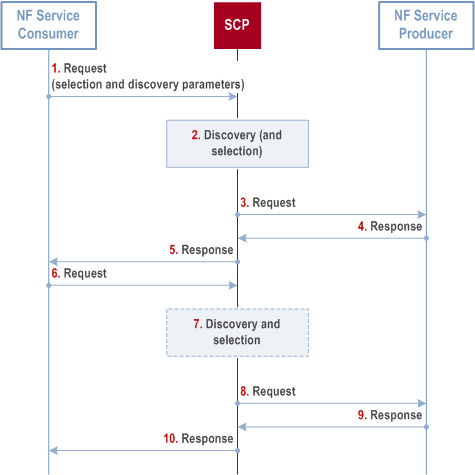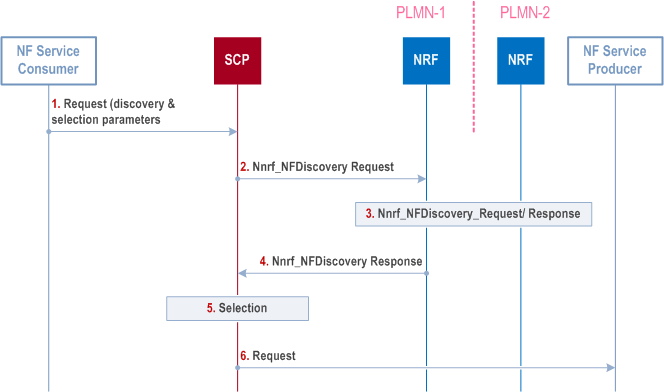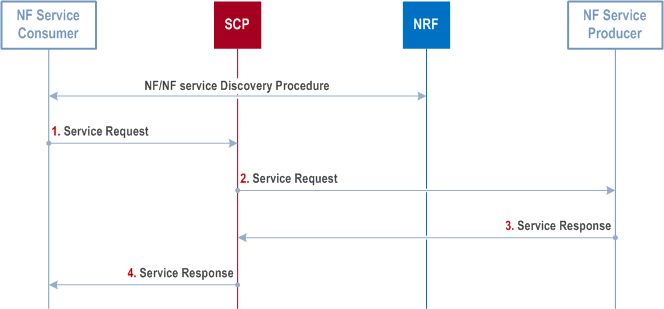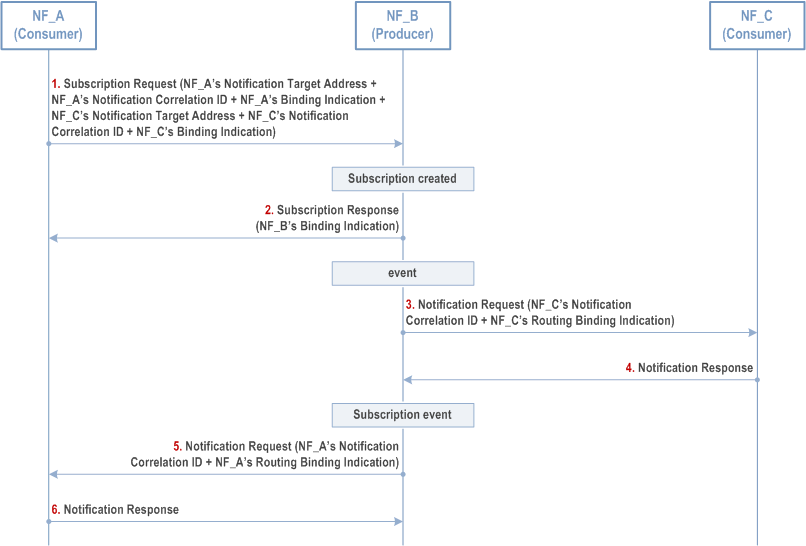Content for TS 23.502 Word version: 19.0.0
1…
4.2.2.2.2
4.2.2.2.3…
4.2.2.3…
4.2.3…
4.2.3.3
4.2.4…
4.2.6
4.2.7…
4.2.9…
4.2.11…
4.2.11.5…
4.3…
4.3.2.2.2
4.3.2.2.3…
4.3.3…
4.3.3.3
4.3.4…
4.3.4.3
4.3.5…
4.3.5.2…
4.3.5.4…
4.3.5.6…
4.3.6…
4.4…
4.5…
4.9…
4.9.1.3…
4.9.2…
4.11…
4.11.1…
4.11.1.2.2
4.11.1.2.3
4.11.1.3…
4.11.1.3.3…
4.11.1.4…
4.11.1.5…
4.11.2…
4.11.3…
4.12…
4.12.6…
4.12a…
4.12b…
4.13…
4.13.4…
4.13.6…
4.14…
4.15…
4.15.3.2.5…
4.15.4…
4.15.6…
4.15.6.7…
4.15.6.13…
4.15.6.14…
4.15.9…
4.15.9.4…
4.15.13…
4.15.13.4…
4.16…
4.16.4…
4.16.8…
4.16.11…
4.16.14…
4.16.15…
4.17…
4.17.9…
4.18…
4.19…
4.22…
4.23…
4.23.7…
4.23.7.3.3
4.23.7.3.4…
4.23.9…
4.23.9.4…
4.23.11…
4.24…
4.25…
4.25.6…
4.26…
5…
5.2.3…
5.2.5…
5.2.6…
5.2.7…
5.2.8…
5.2.9…
5.2.12…
5.2.18…
A…
E…
F…
G
H…
4.17.9 Delegated service discovery when NF service consumer and NF service producer are in same PLMN
4.17.10 Delegated service discovery when NF service consumer and NF service producer are in different PLMNs without NF selection at target PLMN
4.17.10a Indirect Communication with possible delegated service discovery when NF service consumer and NF service producer are in different PLMNs with possible NF selection at target PLMN
4.17.11 Indirect Communication without delegated discovery Procedure
4.17.12 Binding between NF service consumer and NF service producer
4.17.12.1 General
4.17.12.2 Binding created as part of service response
4.17.12.3 Binding created as part of service request
4.17.12.4 Binding for subscription requests
4.17.13 NRF bootstrapping procedure
...
...
4.17.9 Delegated service discovery when NF service consumer and NF service producer are in same PLMN |R16| p. 558

Step 1.
The NF service consumer intends to communicate with an NF service producer. The NF service consumer sends the service request to an SCP. The request may include discovery and selection parameters necessary to discover and select a NF service producer instance. The discovery and selection parameters are included in the request by the NF service consumer in a way that the SCP does not need to parse the request body.
Step 2.
The SCP may perform discovery upon the request either by interacting with an NRF using Nnrf_NFDiscovery service NRF or may use information collected during the previous interactions with an NRF (by the Nnrf_NFDiscovery service or Nnrf_NFManagement_NFStatusNotify service operation). The SCP together with the NRF authorizes the request. The SCP selects the target NF service producer.
Step 3.
If the NF service consumer is authorized to communicate with the NF service producer, the SCP forwards the request to the selected NF service producer according to the configuration of the Network Slice, e.g. the expected NF instances are only reachable by NFs in the same network slice.
Step 4.
The NF service producer sends a response to the SCP. If the request in step 3 creates a resource in the NF service producer, such as depicted in Figure 4.17.9-1, the NF service producer responds with resource information identifying the created resource.
Step 5.
The SCP routes the response to the NF service consumer.
If the NF service consumer receives a resource address, it uses it for subsequent requests regarding the concerned resource. Otherwise, the procedure ends here.
Step 6.
On a subsequent operation on the created resource, the NF service consumer addresses the resource via the resource address returned by the NF service producer at step 4.
Step 7.
The SCP resolves the NF service producer address and selects a target NF service producer instance. The SCP then routes the request to the selected NF service producer instance. See the clause 6.3.1.0 of TS 23.501 for the details of selection of a target NF service producer instance by SCP.
Step 8.
The SCP delivers the request to the NF service producer.
Step 9.
The NF service producer sends a response to the SCP. The NF service producer may respond with an updated resource information different to the one received in the previous response.
Step 10.
The SCP sends a response to the NF service consumer. If the resource information was updated, the NF service consumer uses the received resource information for subsequent operations (requests) on the resource.
4.17.10 Delegated service discovery when NF service consumer and NF service producer are in different PLMNs without NF selection at target PLMN |R16| p. 560

Step 1.
The NF service consumer intends to communicate with an NF service producer. The NF service consumer sends the request to an SCP. The request includes at least the source PLMN ID and the target PLMN ID in the discovery and selection parameters necessary for the SCP to discover and select a NF service producer instance. The discovery and selection parameters are included in the request by the NF service consumer in a way that the SCP does not need to parse the request body.
Step 2.
The SCP recognises that the request is for a NF service producer in another PLMN. SCP interacts with NRF using the Nnrf_NFDiscovery service.
Step 3.
NRF in PLMN-1 and NRF in PLMN 2 interact using the Nnrf_NFDiscovery service. See step 2 in clause 4.17.5.
Step 4.
SCP gets Nnrf_NFDiscovery service response with NF profile(s).
Step 5.
SCP selects a NF service producer instance in PLMN-2.
Step 6.
SCP forwards the request to the selected NF service producer instance in PLMN-2.
Alternatively, SCP may send the discovery request directly to the NRF in PLMN-2, if it has the relevant NRF address and is authorized by the NRF in PLMN-2. Thus step 2 goes from SCP to NRF in PLMN-2 and step 4 goes from NRF in PLMN-2 to SCP and step 3 is omitted.
4.17.10a Indirect Communication with possible delegated service discovery when NF service consumer and NF service producer are in different PLMNs with possible NF selection at target PLMN |R19| p. 560
This flow applies if NF service consumer and NF service producer are in different PLMNs and either "indirect communication without delegated discovery" (Model C in Annex E of TS 23.501) or "indirect communication with delegated discovery" (Model D in Annex E of TS 23.501) is used.

Step 0.
If a NF instance was selected by the NF consumer in step 0, steps 2 to 4 are optional.
For indirect communication without delegated discovery (Model C in Annex E of TS 23.501), the NF-service consumer retrieves NF profiles as shown in Figure 4.17.5-1 and selects either an NF producer instance or an NF instance set.
Step 1.
The NF service consumer intends to communicate with an NF service producer. The NF service consumer sends the request to an SCP. The request includes at least the source PLMN ID and the target PLMN ID in the discovery (only for Model D in Annex E of TS 23.501) and selection parameters necessary for the SCP to discover and select a NF service producer instance. The discovery and selection parameters are included in the request by the NF service consumer in a way that the SCP does not need to parse the request body. For indirect communication without delegated discovery (Model C in Annex E of TS 23.501), see also step 1 of Figure 4.17.11-1.
Step 2.
Steps 5 and 6 apply if steps 2 to 4 were not executed or the Nnrf_
The SCP recognises that the request is for a NF service producer in another PLMN. SCP interacts with NRF using the Nnrf_NFDiscovery service. The SCP may include an indication of "support of indirect communication without delegated discovery with NF selection at target domain feature" (Model C in Annex E of TS 23.501) and/or an indication of "support of indirect communication with delegated discovery with NF selection at target domain feature" (Model D in Annex E of TS 23.501).
Step 3.
NRF in PLMN-1 and NRF in PLMN 2 interact using the Nnrf_NFDiscovery service. See step 2 in clause 4.17.5. If the SCP provided an indication of "support of indirect communication with delegated discovery with NF selection at target domain feature" and/or of "support of indirect communication without delegated discovery with NF selection at target domain feature" in step 2 and the NRF in PLMN-1 supports those features, the NRF in PLMN-1 includes an indication of support of those features.
Based on operator's policy and the received indication of support of related features, the NRF in PLMN-2 provides an NF discovery response that contains one of:
Step 4.
- Either NF profiles matching parameters provided in the NnrfDiscovery request; or
-
If an indication of "support of indirect communication with delegated discovery with NF selection at target domain feature" was received and that option is preferred by NRF in PLMN-2, no candidate NF profiles but the indication that "indirect communication with delegated discovery with NF selection at target domain is requested",. optionally an indication that the reply applies to all NF types (otherwise the indication only relates to the NF type requested in the Nnrf_
NFDiscovery request), and optionally the address of an SCP in PLMN2 where to send the request. -
If an indication of "support of indirect communication without delegated discovery with NF selection at target domain feature" was received and that option is preferred by NRF in PLMN-2, candidate NF profiles and the indication that "indirect communication without delegated discovery with NF selection at target domain is requested", optionally an indication that the reply applies to all NF types (otherwise the indication only relates to the NF type requested in the Nnrf_
NFDiscovery request), and optionally the address of an SCP in PLMN2 where to send the request. -
The NRF in PLMN-1 may cache the response and use it to answer subsequent Nnrf_
NFDiscovery without interactions with the NRF in PLMN-2. If the SCP provided an indication of "support of indirect communication with delegated discovery with NF selection at target domain feature", based on operator's policy and configuration, the NRF in the PLMN-1 may also determine without interaction with the NRF in the PLMN-2 that indirect communication with delegated discovery with NF selection at target domain is requested for that remote PLMN, and the interaction with the NRF in PLMN-2 and step 3 does not apply. The NRF in PLMN-1 may then provide a configured address of an SCP in PLMN2 in the Nnrf_NFDiscovery service response (step 4).
The NRF in PLMN-1 sends an Nnrf_NFDiscovery service response with parameters as described in step 3 to the SCP in PLMN-1. The SCP may cache the response.
Step 5.
Steps 7 to 10 apply if the Nnrf_
If a NF instance was not selected by the NF consumer, SCP in PLMN-1 selects a NF service producer instance in PLMN-2. Otherwise if this is allowed by binding information, the SCP in PLMN-1 may also select a NF service producer instance in PLMN-2
Step 6.
SCP in PLMN-1 forwards the request to the selected NF service producer instance in PLMN-2.
Step 7.
If an indication that "indirect communication without delegated discovery with NF selection at target domain is requested" was received but an NF instance or NF set was not yet selected (because the NF consumer applied model D) the SCP may select an NF producer instance or a NF set (where the SCP in target network need to do the NF instance selection).
If an indication that "indirect communication with delegated discovery with NF selection at target domain is requested" and/or the indication that "indirect communication without delegated discovery with NF selection at target domain is requested" was received, SCP in PLMN-1 forwards the request with discovery and selection parameters to PLMN-2.
Step 8.
Unless the SCP in PLMN-2 has appropriate cached information, it interacts with NRF in PLMN-2 using the Nnrf_NFDiscovery service. Candidate NF profiles are returned.
Step 9.
If a NF instance was not selected, SCP in PLMN-2 selects a NF service producer instance in PLMN-2. Otherwise if this is allowed by binding information, the SCP in PLMN-2 may also reselect a NF service producer instance.
Step 10.
SCP in PLMN-2 forwards the request to the selected NF service producer instance in PLMN-2.
4.17.11 Indirect Communication without delegated discovery Procedure |R16| p. 563
This clause provides the call flow for indirect communication model without delegated discovery.

The NF/NF service discovery procedure is defined in clauses 4.17.4 and 4.17.5. In a successful discovery the NF service consumer gets the NF profile(s) matching the search criteria provided in the Nnrf_NFDiscovery_Request message.
Step 1.
When the NF Service Consumer needs to send a Service Request and has obtained an endpoint address for the appropriate resources of the NF service producer from the reply to a previous service operation, the NF Service Consumer should indicate that endpoint address as target for the Service Request. Otherwise, if the NF Service Consumer has stored results from the Discovery Procedure, the NF Service Consumer selects an appropriate NF Producer / NF Service Producer instance from the list of NF profiles provided by the NRF. The NF Service Consumer considers the NF and NF service parameters (e.g. TAI, S-NSSAI, locality, priority etc) in the NF profiles. The NF Service consumer requests service from the NF Service producer by sending a service request message to the NF service producer via the SCP and the NF Service Consumer may provide a Routing Binding Indication with the same contents as the previously received Binding Indication.
Step 2.
If the Routing Binding Indication is provided by the NF Service Consumer, SCP (re-)selects as specified in Table 6.3.1.0-1 of TS 23.501 and routes the service request to target accordingly. If the Routing Binding Indication is not provided by the NF Service Consumer, then the SCP routes the service request based on routing information available.
Step 3.
The NF Service Producer responds via SCP.
Step 4.
SCP forwards the response.
4.17.12 Binding between NF service consumer and NF service producer |R16| p. 563
4.17.12.1 General p. 563
This clause describes the procedures to establish binding between the NF service consumer and producer.
Direct Communication or Indirect Communication procedures may be used between the Consumer and Producer. In the case of Indirect Communication, an SCP is located between the Consumer and Producer.
4.17.12.2 Binding created as part of service response p. 563
When the NF service consumer communicates with the NF service producer, the producer may return a binding indication to the consumer. The consumer stores the received binding indication and uses it for the subsequent requests concerning the data context.

Step 1.
If Direct Communication is used, the NF service consumer selects the NF service producer and sends the request to the selected NF service producer. If Indirect Communication without delegated discovery is used, the NF service consumer selects the NF service producer set or instance and sends the request to the selected NF service producer via the SCP; if the NF service consumer only selects the NF service producer set, it provides the necessary selection parameters and the SCP selects the NF service producer instance. If Indirect Communication with delegated discovery is used, the NF service consumer sends the request to the SCP and provides within the service request to the SCP the discovery and selection parameters necessary to discover and select a NF service producer.
Step 2.
The NF service producer sends a response to the NF service consumer. In the response the NF service producer may include a binding indication. If the NF service consumer receives a resource information and binding indication as specified in Table 6.3.1.0-1 of TS 23.501, it uses them for subsequent requests regarding the concerned resource. Otherwise, the procedure ends here.
Step 3.
The NF service consumer uses the binding indication and resource information received in the previous step for subsequent requests regarding the concerned resource. If indirect communication with delegated discovery is used, the NF service consumer includes a Routing Binding Indication with the same contents as the received Binding Indication. If indirect communication without delegated discovery is used, the NF service consumer also includes the Routing Binding Indication with the same contents as the received Binding Indication unless the NF service consumer performs a reselection. The SCP shall route the service request using the Routing Binding Indication and resource information sent from the NF service consumer.
Step 4.
The NF service producer sends a response to the consumer. The NF service producer may respond with an updated binding indication, different to the one received in the previous response.
4.17.12.3 Binding created as part of service request p. 564
If the NF service consumer can also be as a NF service producer for later communication from the contacted producer, a service request sent to the producer may include binding indication.

Step 1.
Instance A, as an NF service consumer sends a service request using either Direct Communication or Indirect communication via SCP and Instance B is selected as NF service producer. If Instance A can also be NF service producer for later communication for the concerned data context, it may include binding indication referring to NF service instance, NF service set, NF instance or NF Set as specified in Table 6.3.1.0-1 of TS 23.501 in the request sent to the NF service producer; the binding indication shall be associated with an applicability indicating "other service" and include the service name. In this case, if indirect communication is used, the SCP sends to the Instance B the service request including the binding indication.
Step 2.
Instance B as the NF service producer sends a response to the NF service consumer.
Step 3.
When Instance B as NF service consumer needs to invoke the service provided by Instance A, Instance B sends a request using the binding indication received in step 1 as described in Steps 3-4 in Figure 4.17.12.2-1 with the following difference:
- Based on the received binding indication, if delegated discovery is not used, the Instance B may need to discover the corresponding endpoint address of the Instance A.
4.17.12.4 Binding for subscription requests p. 565
Binding for notifications can be created as part of an explicit or implicit subscription request. In this case, illustrated in Figure 4.17.12.4-1, the subscription request may include a Binding Indication 1 referring to NF service instance, NF service Set, NF instance or NF Set and additionally includes a service name of the NF service consumer as specified in Table 6.3.1.0-1 of TS 23.501. The NF Service Set ID, NF service instance ID and service name relate to the service of a NF service consumer that will handle the notification.
For direct communication, the NF service producer selects the target for the related notifications using the notification endpoint received in the subscription request. If the notification endpoint included in the subscription is not reachable, the Binding Indication received is used to discover an alternative notification endpoint, as specified in Table 6.3.1.0-1 of TS 23.501.
For indirect communication, the NF service producer includes the notification endpoint received in the subscription and may include a Routing Binding Indication with the same contents as the received Binding Indication. If the notification endpoint included in the subscription is not reachable, the SCP selects the target for the related notifications using the received Routing Binding Indication as specified in Table 6.3.1.0-1 of TS 23.501.
If the Binding Indication for Notifications needs to be updated, the NF service consumer may initiate a new Subscription request to the NF service producer with an updated Binding Indication or may include the Binding Indication in the acknowledgment of a Notification. A Subscription request may also contain updated Notification Correlation ID and Notification Target Address.
Binding for the subscription resource at the NF service producer can also be created: The Subscription Response message may contain a Binding Indication 2 referring to NF service instance, NF instance or NF Set of the NF service producer.
For direct communication, the NF service consumer selects the target for the related request to the producer, such as the request to update the subscription shown in Figure 4.17.12.4-1, using the received Binding Indication 2 as specified in Table 6.3.1.0-1 of TS 23.501.
For indirect communication with delegated discovery, the NF service consumer includes a Routing Binding Indication with the same contents as the received Binding Indication 2. For indirect communication without delegated discovery, the NF service consumer also includes the Routing Binding Indication with the same contents as the received Binding Indication 2 unless it performs a reselection. The SCP selects the target for the related request using the received Routing Binding Indication 2 as specified in Table 6.3.1.0-1 of TS 23.501.
If the Binding Indication for Subscription needs to be updated, the NF service producer may provide an updated binding indication in a notification request to the NF service consumer or in the response to a subsequent subscription update request from the NF service consumer.


An NF service consumer may subscribe via another network function. For example, NF_A may subscribe to NF_B on behalf of NF_C. NF_A additionally subscribe to subscription related events. In this case, both the binding indication from NF_C and NF_A are provided to the NF service producer NF_B. The Binding Indication for notifications to subscription related events shall be associated with an applicability indicating "subscription events".
The NF_C's binding indication is used for reselection of a notification endpoint, which is used for event notification. The NF_A's binding indication is used for reselection of a notification endpoint, which is used for subscription change event notification.
4.17.13 NRF bootstrapping procedure |R17| p. 567
